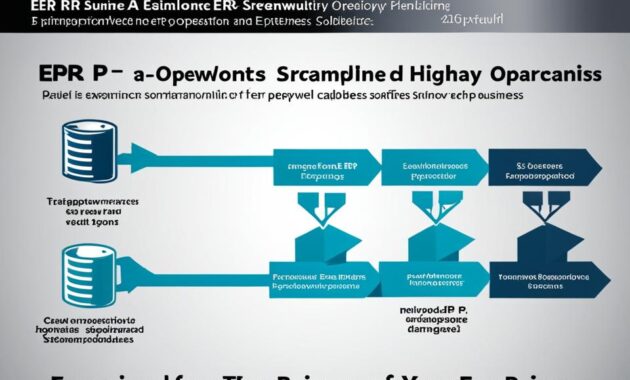In today’s dynamic business landscape, enterprise resource planning (ERP) software has emerged as a transformative solution for organizations seeking to optimize their operations and gain a competitive edge. ERP systems integrate and automate core functions, such as finance, human resources, supply chain, and inventory management, into a centralized platform. By unifying data and processes, ERP software empowers businesses to enhance efficiency, make data-driven decisions, and ultimately, achieve greater success.
Key Takeaways
- ERP software integrates and automates core business functions, enabling streamlined operations.
- Centralized data and processes provide a comprehensive view of the organization, facilitating informed decision-making.
- ERP systems enhance efficiency, improve productivity, and support data-driven strategies.
- Selecting the right ERP solution involves assessing business needs and evaluating vendors.
- Implementing ERP software can lead to significant improvements in overall business performance.
What is Enterprise Resource Planning Software?
Enterprise resource planning (ERP) software is a comprehensive business management system that integrates and automates core business functions, such as finance, human resources, supply chain, and inventory management. ERP systems consolidate data from various departments into a centralized database, enabling seamless communication and collaboration across the organization.
Integrating Business Processes
ERP software is designed to streamline operations by integrating different business processes into a single, unified system. This integration allows businesses to eliminate data silos, improve efficiency, and make data-driven decisions. From managing financial transactions to tracking inventory levels, ERP solutions provide a centralized platform for managing all aspects of an organization’s operations.
Real-time Data and Analytics
One of the key benefits of enterprise resource planning software is its ability to provide real-time data and analytics. ERP systems gather information from various sources within the organization and present it in a user-friendly dashboard, giving business leaders the insights they need to make informed strategic decisions. This real-time data access enables organizations to respond quickly to changing market conditions and optimize their operations accordingly.
Overall, enterprise resource planning software is a powerful tool that can help businesses streamline their operations, improve efficiency, and make data-driven decisions. By integrating core business functions and providing real-time data and analytics, ERP solutions can be a game-changer for organizations looking to gain a competitive edge in the market.
Key Benefits of Enterprise Resource Planning Software
Implementing an enterprise resource planning (ERP) system can provide businesses of all sizes and industries with numerous advantages. By integrating and automating core business processes, ERP software helps organizations enhance efficiency, boost productivity, and make more informed decisions.
One of the primary benefits of ERP solutions is improved efficiency and productivity. By eliminating redundant tasks and reducing errors, ERP systems streamline operations, allowing businesses to focus on their core objectives. Additionally, the real-time data and comprehensive analytics offered by ERP platforms enable leaders to make data-driven decisions that drive growth and profitability.
Moreover, ERP software provides enhanced visibility and control across the organization. By offering a centralized view of the entire business, ERP solutions optimize inventory management, supply chain processes, and financial oversight, ultimately enhancing overall operational efficiency.
Another key advantage of ERP systems is improved collaboration and communication between departments. By serving as a single source of truth for all business data, ERP platforms facilitate cross-functional cooperation and information sharing, leading to better informed and more aligned decision-making.
Lastly, ERP solutions are designed to be scalable and adaptable, allowing businesses to grow and evolve alongside changing needs and industry requirements. As organizations expand, ERP systems can accommodate new processes, locations, and user requirements, ensuring a seamless and integrated approach to business management.

From streamlining operations and enhancing decision-making to improving collaboration and facilitating scalability, the benefits of enterprise resource planning software are clear. By investing in the right ERP solution, businesses can unlock a new level of efficiency, visibility, and agility, ultimately driving long-term success and growth.
Choosing the Right ERP Solution
When selecting an enterprise resource planning (ERP) software solution, it’s crucial to assess your business’s specific needs and requirements. This will help you identify the essential features and functionalities that your organization requires from an ERP system.
Assessing Your Business Needs
Begin by evaluating your company’s industry, size, and growth plans. This information will guide you in determining the essential capabilities your ERP solution must possess, such as industry-specific functionality, scalability, and integration with existing systems. Consider factors like your current and future operational needs, reporting requirements, and the level of customization required to meet your unique business processes.
Evaluating ERP Vendors
Once you have a clear understanding of your business needs, research and compare various ERP vendors and their solutions. Examine the features, functionality, and user-friendliness of the software, as well as the vendor’s industry experience, customer support, and implementation services. Carefully assess the integration capabilities of the ERP system and its compatibility with your existing technology infrastructure. Additionally, consider the vendor’s financial stability, longevity in the market, and their commitment to ongoing software updates and enhancements.

